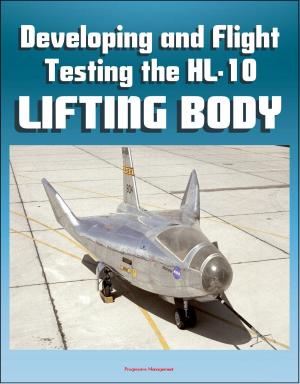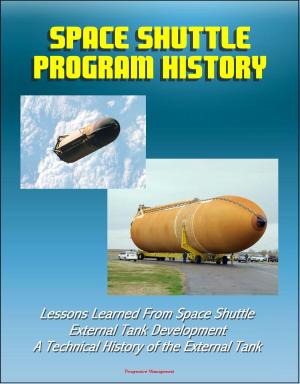Fairing Well: Aerodynamic Truck Research at NASA's Dryden Flight Research Center - From Shoebox to Bat Truck and Beyond, Drag, Mack, Kenworth, Peterbilt, International, Fuel Efficiency, Cabover
Nonfiction, Science & Nature, Technology, Engineering, Automotive, Aeronautics & Astronautics| Author: | Progressive Management | ISBN: | 9781311105943 |
| Publisher: | Progressive Management | Publication: | May 3, 2015 |
| Imprint: | Smashwords Edition | Language: | English |
| Author: | Progressive Management |
| ISBN: | 9781311105943 |
| Publisher: | Progressive Management |
| Publication: | May 3, 2015 |
| Imprint: | Smashwords Edition |
| Language: | English |
Professionally converted for accurate flowing-text e-book format reproduction, this NASA report reviews research conducted by NASA on the aerodynamic efficiency of long-haul trucks. It may seem to be only a matter of fuel prices, drag coefficients, and vehicle modifications, but a nuanced examination of the subject reveals cultural influences on a technological development that might otherwise appear logical and straightforward. There are two principal objectives to this monograph. The first is to bring long overdue attention to research done at NASA Dryden on truck aerodynamics, work not usually associated with the agency but results from which had and continue to have a direct benefit to the U.S. economy. The second is to use this case as on opportunity to tease apart some of the strands of the social fabric in technology's construction and adaptation, something not regularly done with NASA's technical work. If we genuinely seek to understand ourselves, we can ill afford superficial attention to technological choices we — or others—make regarding its use, rejection, adoption, or adaptation. It's important to know who makes what decisions: the results can be surprising.
A reflection on NASA's interest in aerodynamically efficient trucks turns out to be more than just an account of fairings and base drag and surface roughness. This history is also about technological choices, cultural values, and how Americans define themselves. And since technology is a reflection of human choices and values this comes as no real surprise.
While regularly riding his bicycle from his home in North Edwards to the NASA Flight Research Center (today's Dryden Flight Research Center) on Edwards Air Force Base, Edwin J. "Ed" Saltzman noticed the push and pull of tractor-trailers as they passed him. Saltzman's route took him along a section of Highway 58 in Southern California's High Desert before veering off toward the base. The Dryden Flight Research Center is one of several tenants of the U. S. Air Force at Edwards. Highway 58 was, and is frequented by trucks coming from Arizona, Nevada, or Northern California that seek to avoid the greater Los Angeles area. As these tractor-trailers came upon Saltzman he first felt the bow wave of air pushing him away from the road and toward the sagebrush and tumbleweeds. But as the trucks swept past, their wakes had the opposite effect, tending to draw him toward the road, even causing rider and bicycle to lean into the lane. Anyone who's ridden a bicycle next to fast-moving traffic has felt some of this, although the full effect is available only to those bold enough to mingle with over-the-road tractor-trailers at highway speeds.
Saltzman came to the High Desert in 1951 to work as an engineer for the NACA, just four years after a human first successfully exceeded the speed of sound. He cut his aeronautical engineering teeth on the X-1 rocket planes that were still being used to explore the transonic and supersonic realms. In 1953, as the X-1 program wound down and the first Mach 2 flight took place, he began working on "Project 1226," later known as the X-15. The flight portion of the X-15 program lasted from 1959 to 1968, but it was preceded by years of engineering work to which Saltzman contributed. As he had on the X-1 program, he worked as an aerodynamicist focusing on questions of lift-to-drag ratios (L/D). While the NACA's X-1 and D-558-2 aircraft featured blunt afterbodies because of their rocket motors, the X-15 dwarfed both in terms of the rocket nozzle area and the resulting drag the aft end generated. Even before the X-15 program ended, Saltzman transferred to the XB-70 program, working on the Mach 3 experimental bomber that never saw production but which NASA used to explore high-speed atmospheric flight.
Professionally converted for accurate flowing-text e-book format reproduction, this NASA report reviews research conducted by NASA on the aerodynamic efficiency of long-haul trucks. It may seem to be only a matter of fuel prices, drag coefficients, and vehicle modifications, but a nuanced examination of the subject reveals cultural influences on a technological development that might otherwise appear logical and straightforward. There are two principal objectives to this monograph. The first is to bring long overdue attention to research done at NASA Dryden on truck aerodynamics, work not usually associated with the agency but results from which had and continue to have a direct benefit to the U.S. economy. The second is to use this case as on opportunity to tease apart some of the strands of the social fabric in technology's construction and adaptation, something not regularly done with NASA's technical work. If we genuinely seek to understand ourselves, we can ill afford superficial attention to technological choices we — or others—make regarding its use, rejection, adoption, or adaptation. It's important to know who makes what decisions: the results can be surprising.
A reflection on NASA's interest in aerodynamically efficient trucks turns out to be more than just an account of fairings and base drag and surface roughness. This history is also about technological choices, cultural values, and how Americans define themselves. And since technology is a reflection of human choices and values this comes as no real surprise.
While regularly riding his bicycle from his home in North Edwards to the NASA Flight Research Center (today's Dryden Flight Research Center) on Edwards Air Force Base, Edwin J. "Ed" Saltzman noticed the push and pull of tractor-trailers as they passed him. Saltzman's route took him along a section of Highway 58 in Southern California's High Desert before veering off toward the base. The Dryden Flight Research Center is one of several tenants of the U. S. Air Force at Edwards. Highway 58 was, and is frequented by trucks coming from Arizona, Nevada, or Northern California that seek to avoid the greater Los Angeles area. As these tractor-trailers came upon Saltzman he first felt the bow wave of air pushing him away from the road and toward the sagebrush and tumbleweeds. But as the trucks swept past, their wakes had the opposite effect, tending to draw him toward the road, even causing rider and bicycle to lean into the lane. Anyone who's ridden a bicycle next to fast-moving traffic has felt some of this, although the full effect is available only to those bold enough to mingle with over-the-road tractor-trailers at highway speeds.
Saltzman came to the High Desert in 1951 to work as an engineer for the NACA, just four years after a human first successfully exceeded the speed of sound. He cut his aeronautical engineering teeth on the X-1 rocket planes that were still being used to explore the transonic and supersonic realms. In 1953, as the X-1 program wound down and the first Mach 2 flight took place, he began working on "Project 1226," later known as the X-15. The flight portion of the X-15 program lasted from 1959 to 1968, but it was preceded by years of engineering work to which Saltzman contributed. As he had on the X-1 program, he worked as an aerodynamicist focusing on questions of lift-to-drag ratios (L/D). While the NACA's X-1 and D-558-2 aircraft featured blunt afterbodies because of their rocket motors, the X-15 dwarfed both in terms of the rocket nozzle area and the resulting drag the aft end generated. Even before the X-15 program ended, Saltzman transferred to the XB-70 program, working on the Mach 3 experimental bomber that never saw production but which NASA used to explore high-speed atmospheric flight.















